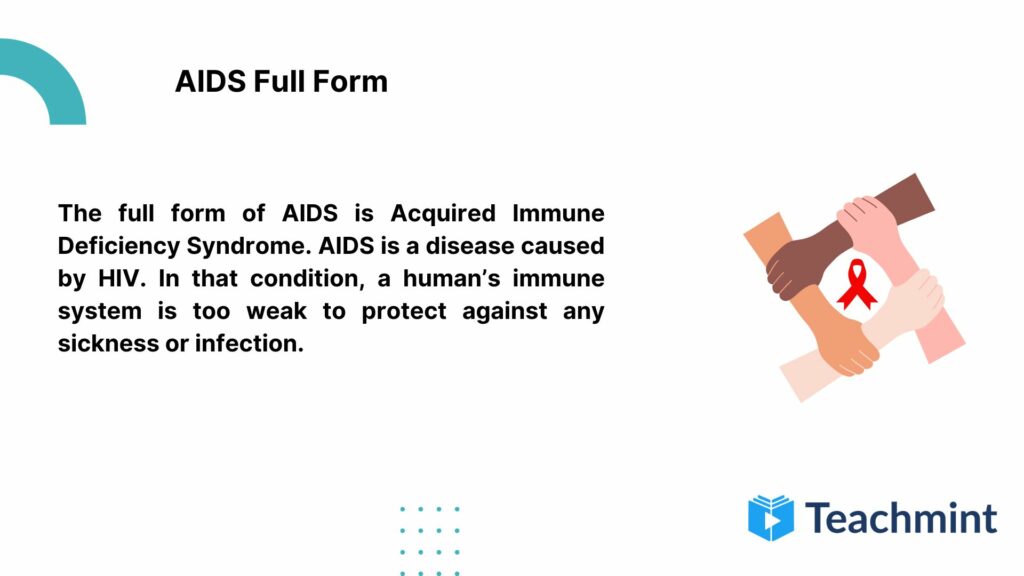Introduction: In the landscape of global health, few terms resonate as profoundly as AIDS. The acronym stands for Acquired Immunodeficiency Syndrome, a condition caused by the Human Immunodeficiency Virus (HIV). Beyond its medical definition, AIDS embodies a complex web of social, economic, and cultural implications. This article delves into the multifaceted nature of HIV/AIDS, exploring its impact, challenges, and ongoing efforts to address the epidemic.

- Understanding AIDS:
- Acquired Immunodeficiency Syndrome (AIDS Full Form) Defined: AIDS is the advanced stage of HIV infection, characterized by severe damage to the immune system. It occurs when the virus has depleted the body’s CD4 cells, leaving it vulnerable to opportunistic infections and cancers.
- Historical Context: The identification of AIDS in the early 1980s marked the beginning of a global health crisis. Initially perceived as a mysterious and fatal disease, AIDS sparked fear and misinformation, contributing to stigma and discrimination against affected individuals.
- The HIV Epidemic:
- Global Impact: HIV/AIDS has emerged as one of the most significant public health challenges of our time, affecting millions of people worldwide. Sub-Saharan Africa remains the hardest-hit region, but the epidemic has also taken a toll on other parts of the world, including Asia, Eastern Europe, and the Americas.
- Key Populations: Certain groups are disproportionately affected by HIV/AIDS, including men who have sex with men, people who inject drugs, sex workers, transgender individuals, and prisoners. Stigma, discrimination, and legal barriers often exacerbate their vulnerability to infection and hinder access to healthcare services.
- Challenges in HIV/AIDS Prevention and Treatment:
- Stigma and Discrimination: Despite advances in medical science, stigma remains a significant barrier to HIV prevention, testing, and treatment. Fear of discrimination discourages individuals from seeking care and disclosing their HIV status, perpetuating the spread of the virus.
- Access to Healthcare: Disparities in healthcare access and infrastructure pose challenges in delivering HIV/AIDS prevention and treatment services, particularly in low- and middle-income countries. Limited resources, weak healthcare systems, and geographical barriers hinder efforts to reach those in need.
- Progress and Innovations:
- Antiretroviral Therapy (ART): The introduction of ART has revolutionized the management of HIV/AIDS, allowing people living with the virus to lead longer and healthier lives. ART suppresses viral replication, reduces the risk of transmission, and improves immune function.
- Prevention Strategies: A combination of prevention approaches, including condom use, pre-exposure prophylaxis (PrEP), harm reduction programs, and voluntary medical male circumcision, have proven effective in reducing HIV transmission rates.
- The Road Ahead:
- Ending the Epidemic: The global community has set ambitious targets to end the AIDS epidemic by 2030, as outlined in the United Nations Sustainable Development Goals. Achieving this goal requires sustained political commitment, increased funding, and innovative approaches to HIV prevention, testing, and treatment.
- Addressing Social Determinants: Tackling the root causes of HIV/AIDS, including poverty, gender inequality, stigma, and discrimination, is essential for sustainable progress. Promoting human rights, access to education, economic empowerment, and social justice are integral to ending the epidemic.
Conclusion: The acronym AIDS encapsulates a complex interplay of medical, social, and structural factors that define the HIV/AIDS epidemic. While significant strides have been made in prevention, treatment, and advocacy, challenges persist in the global response to HIV/AIDS. By addressing stigma, discrimination, and healthcare disparities, and promoting inclusive and rights-based approaches, we can work towards a future where AIDS no longer poses a threat to public health and human dignity.
Learn more about Teachmint plans here.

